TABLE A Comparative Construction Statistics |
|---|
Fourth Quarter, 2016 and 2015(Details may not add-up to total due to rounding) |
| Type of Construction | Fourth Quarter 2016 (October - December) |
Fourth Quarter 2015 |
| TOTAL |
|
|
| Number | 32,282 |
31,638 |
| Floor Area (sq.m.) | 7,033,436 |
6,246,222 |
| Value (PHP '000) | 82,447,378 |
68,615,994 |
| Residential |
|
|
| Number | 24,752 |
24,274 |
| Floor Area (sq.m.) | 3,913,675 |
3,211,972 |
| Value (PHP '000) | 47,476,193 |
29,990,581 |
| Non-Residential |
|
|
| Number | 3,981 |
3,717 |
| Floor Area (sq.m.) | 3,011,443 |
2,893,233 |
| Value (PHP '000) | 29,013,649 |
33,885,772 |
| Addition |
|
|
| Number | 883 |
981 |
| Floor Area (sq.m.) | 108,318 |
141,017 |
| Value (PHP '000) | 710,815 |
1,122,088 |
| Alteration and Repair |
|
|
| Number | 2,666 |
2,666 |
| Value (PHP '000) | 5,246,721 |
3,617,553 |
Constructions projects slightly grow by 2.0 percent in the fourth quarter
- Total number of constructions recorded from approved building permits in the fourth quarter of 2016 reached 32,282. This number represents an increase of 2.0 percent from the 31,638 constructions during the same quarter of 2015.
- Residential constructions also grew by 2.0 percent to 24,752 from 24,274 reported units during the same period of 2015. The drivers of growth in the residential constructions were residential condominiums (93.3%), apartment/accessoria (56.6%), and other residential units (30.8%). On the other hand, reductions were noted in the construction of duplex/quadruplex (-18.5%) and single type houses (-0.7%).
- Non-residential constructions numbering to 3,981 posted 7.1 percent increase from 3,717 recorded units during the same period a year ago. The increase in number of agricultural (29.2%), industrial (21.3%), and commercial (7.9%) buildings contributed to the growth of non-residential constructions.
- On the other hand, addition to existing structures declined by 10.0 percent to 883 from 981 units posted during the same period of 2015. Meanwhile, alteration and repair of existing structures recorded the same number of projects (2,666) from the same period last year. Figure 1 compares the number of constructions by type for the fourth quarters of 2016 and 2015.
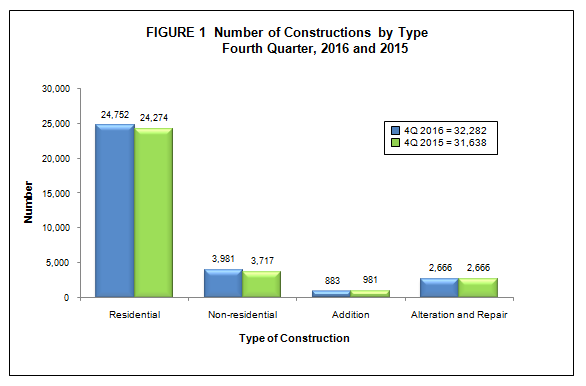
- The top five regions accounted for 59.5 percent of the total number of constructions in the fourth quarter of 2016. Region IVA (CALABARZON) led other regions where a total of 7,510 constructions (23.3%) were located. This was followed by Region VII (Central Visayas) with 3,342 constructions (10.4%). Other regions in the top five list are:
- Region III (Central Luzon) with 3,097 constructions (9.6%)
- National Capital Region (NCR) with 2,694 constructions (8.3%)
- Region XI (Davao Region) with 2,559 constructions (7.9%)
Figure 2 shows the distribution of constructions by region.
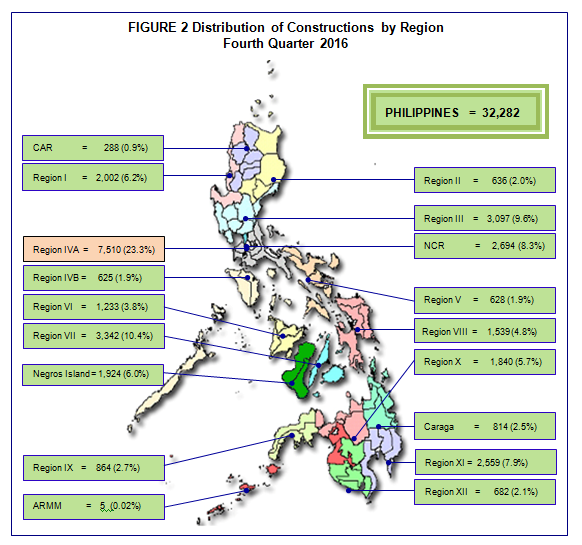
- At the provincial level, nine out of the top ten provinces in the fourth quarter of 2015 remained in the top ten list in the fourth quarter of 2016. Leyte climbed to 10th place from 26th place, replacing Misamis Oriental which ranked 9th in 2015. These top ten provinces comprised 46.8 percent of the total number of constructions.
- Cavite occupied the top spot with 3.952 constructions (12.2%). Cebu with 1,865 constructions (5.8%) and Bohol with 1,447 constructions (4.5%) placed second and third, respectively. Completing the top ten provinces with the most number of constructions were:
- Davao del Sur with 1,315 constructions (4.1%)
- Laguna with 1,221 constructions (3.8%)
- Bulacan with 1,137 constructions (3.5%)
- Fourth District with 1,131 constructions (3.5%)
- Negros Oriental with 1,054 constructions (3.3%)
- Batangas with 1,043 constructions (3.2%)
- Leyte with 940 constructions (2.9%)
- The number of constructions in Leyte grew by 131.5 percent, the highest among the top ten provinces. This was brought about by the significant growth in the construction of apartment/accessoria (613.8%) in the province.
Total value of constructions up by 20.2 percent
- Total value of constructions amounted to PHP82.4 billion, an increase of 20.2 percent from PHP68.6 billion recorded during the fourth quarter of 2015.
- Value of residential constructions estimated at PHP47.5 billion climbed by 58.3 percent from PHP30.0 billion recorded during the same quarter of 2015. This was influenced by the high increase in the construction value of residential condominiums (140.0%), other residential units (126.9%), apartment/accessoria (60.4%) and single houses (20.8%). On the other hand, duplex/quadruplex decreased in value by 10.9 percent compared to the same quarter last year.
- Value of non-residential constructions amounting to PHP29.0 billion declined by 4.4 percent compared with PHP33.9 billion registered during the same quarter of 2015.This was attributed to the decline in the construction value of industrial (-41.7%), other non-residential (-29.9%), institutional (-10.8%) and commercial (-2.4%) buildings; offsetting the growth in the construction value of agricultural buildings (25.9%).
- Similarly, construction value of addition to existing structures estimated at PHP0.7 billion dropped by 36.7 percent from PHP1.1 billion recorded during the same period in 2015. On the other hand, alteration and repair of existing structures valued at PHP5.2 billion was up by 45.0 percent compared with PHP3.6 billion recorded in 2015. Figure 3 compares the value of constructions by type for the fourth quarters of 2016 and 2015.
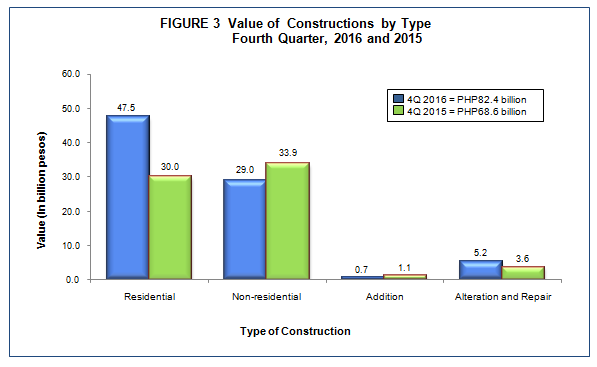
- Across the country, combined construction value of the top five regions amounted to PHP61.7 billion which comprised 74.9 percent of the total. NCR, ranking fourth in the number of constructions, consistently remained highest in terms of value of construction estimated at PHP30.3 billion or 36.7 percent of the total. This was followed by CALABARZON and Central Visayas with respective construction value of PHP13.7 billion (16.6%) and PHP7.6 billion (9.3%).Central Luzon with construction value of PHP6.1 billion (7.4%) and Negros Island Region with PHP4.0 billion (4.9%), placed fourth and fifth, respectively.
Average cost of residential-type building is at PHP12,131 per square meter
- Average cost of residential building for the fourth quarter of 2016 was estimated at PHP12,131 per square meter, an increase of 29.9 percent compared with previous year’s average cost of PHP9,337. This was brought about by the increments in the average cost per square meter of residential condominiums (52.9%), other residential (37.5%), duplex/quadruplex (23.0%), apartment/accessoria (13.6%) and single-type houses (11.3%).
- Among residential constructions, single-type houses recorded the most number of units with 20,889 accounting for 84.4 percent of the total. Total value of construction for this type amounted to PHP20.3 billion covering a total floor area of 2.1 million square meters or an average cost of PHP9,650 per square meter.
- Apartment/accessoria-type ranked a far second with 3,427 units or 13.8 percent of the total residential construction. This type of construction valued at PHP6.7 billion had a total floor area of 818.8 thousand square meters or an average cost of PHP8,124 per square meter.
- Duplex/quadruplex-type dwellings came next with 327 units or 1.3 percent of the total residential construction. Construction value for this type amounted to PHP0.4 billion with a total floor area of 45.0 thousand square meters or an average cost of PHP9,996 per square meter.
- Residential condominiums numbering to only 58 made up of only 0.2 percent with construction value of PHP20.0 billion and total floor area of 936.1 thousand square meters, translating to an average cost of PHP21,336 per square meter. Figure 4 displays the number and value of residential constructions by type for the fourth quarter of 2016.
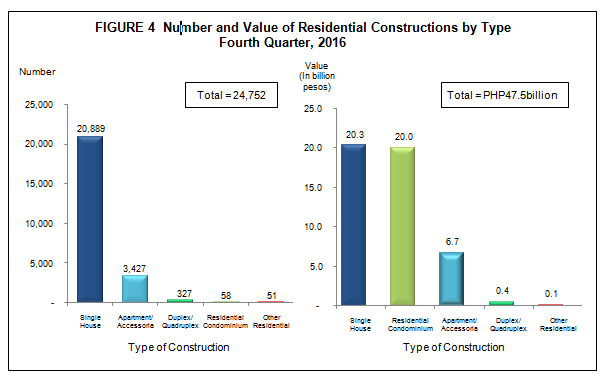
Average cost of non-residential construction is PHP9,634 per square meter
- Average cost per square meter of non-residential constructions declined by 17.7 percent to PHP9,634 from PHP11,712 recorded during the same quarter last year. This was brought about by the two-digit decreases in the average cost per square meter of industrial (-56.3%), other non-residential (-29.9%), agricultural (-23.4%) and institutional (-12.2%) buildings.
- Commercial-type buildings dominated all other types of non-residential constructions with 2,485 projects or 62.4 percent of the total. Construction value for this type was estimated at PHP16.8 billion with a total floor area of 1.5 million square meters or an average cost of PHP11,294 per square meter.
- Institutional-type buildings distantly followed with 736 units (18.5%). This type of construction valued at PHP5.9 billion had a total floor area of 543.6 thousand square meters or an average cost of PHP10,783 per square meter.
- Industrial-type buildings came next with 485 units (12.2%). Total construction value for this type was estimated at PHP5.4 billion with total floor area of 753.0 thousand square meters or an average cost of PHP7,213 per square meter.
- Agricultural-type buildings recorded the least with186 units or 4.7 percent of the total non-residential construction. Construction value for this type amounted to PHP0.8 billion with total floor area of 228.6 thousand square meters or an average cost of PHP3,702 per square meter. Figure 5 shows the number and value of non-residential constructions by type for the fourth quarter of 2016.
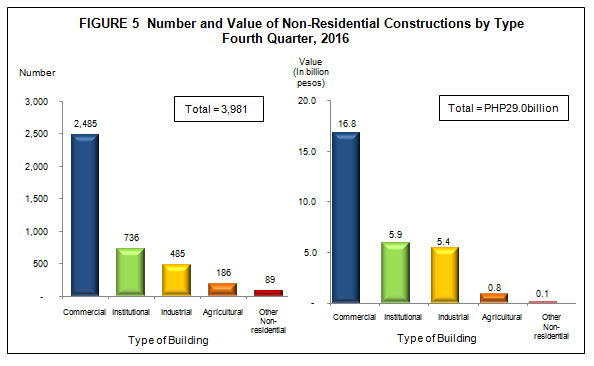
TECHNICAL NOTES
CONSTRUCTION STATISTICS FROM APPROVED BUILDING PERMITS
Introduction
This Special Release presents the preliminary data on construction statistics from approved building permits for the fourth quarter of 2016, generated 60 calendar days after the reference quarter.
For this publication, data for Lanao Del Sur and Sulu are not included in the tabulation as these provinces did not submit any approved building permit document and/or certificate of no construction before the generation of preliminary tables. However, if any, these are to be included in the annual tabulation.
Data are presented at the provincial level by type of construction in Tables 1 to 7. Data for the newly created Negros Island Region, comprising the provinces of Negros Occidental and Negros Oriental, are also included in this publication.
Scope and Coverage
Construction statistics from approved building permits relate to administrative-based data on new constructions and additions, alterations and repairs of existing residential and non-residential buildings and other structures proposed to be constructed in all cities and municipalities of the country in a specific period.
Sources of Information
Construction statistics are compiled by the Philippine Statistics Authority (PSA) from the copies of original application forms of approved building permits as well as from the demolition and fencing permits collected every month by the office field personnel from the Offices of Local Building Officials (LBOs) nationwide.
Limitations
- Data on building constructions refer to those approved applications during the reference period and not to construction work completed during the reference period.
- The completeness of the number of building permits collected relies on the approval of applications filed with the LBOs. Hence, private building constructions without approved building permits are excluded in the tabulation of data.
Geographic Classification
Building constructions are classified and presented by geographic area using the Philippine Standard Geographic Classification (PSGC) as of December 2014. The PSGC contains the latest updates on the official number of regions, provinces, cities, municipalities and barangays in the Philippines.
Industry Classification
Construction statistics utilizes the 2009 Philippine Standard Industrial Classification (PSIC) to identify the industrial classification of the structure proposed for construction through its use or character of occupancy.
Collection
The number of building permit forms accomplished by the applicant comes in five (5) copies. The “NSO copy” of the approved building permit is made available within the first five (5) working days after each reference month. Collections of these documents from the LBO in city/municipality are undertaken by PSA field personnel within this period.
Collected documents for each month are properly checked as to its completeness by verifying the beginning and ending numbers indicated in the permit numbers. Missing numbers are indicated, with corresponding reasons, in the transmittal. In cases where there is no construction in a given month in a municipality, a certification that there was no approved building permit during the reference period is provided by the LBO to the PSA field staff.
Data Processing
Data processing of approved building permits is done both manually and mechanically. Copies of documents collected from the offices of LBOs are properly controlled, sorted, edited and coded, folioed and encoded in the PSA provincial offices. During machine validation, inconsistent and invalid entries which are flagged in an error listing are corrected in the data file. This process is repeated until there are no more inconsistent or erroneous entries found in the error listing. The data files are then forwarded to PSA Central Office for validation, consolidation and generation of preliminary tables. Data files received after the cut-off dates of submission set for each quarter are included in the generation of annual tables.
Preliminary results are based from data files that have undergone data processing in the provincial offices and have been validated at the Central Office. The preliminary tables are revised to include building permit documents received after the cut-off period in the annual tabulation.
Statistics Generated
Construction statistics generated from approved building permits provide monthly administrative-based data on building construction at the municipality level nationwide. Statistics generated are the following:
- number
- floor area
- type of construction
- value of construction
Statistical Tables
The statistical tables are presented at the regional and provincial levels by type of construction and by period according to form of ownership.
Unpublished Data
Aside from the preliminary tables posted in the PSA website, annual, quarterly and monthly statistical tables at the municipality level by type of construction and by form of ownership are available at the Industry Statistics Division of the PSA.
Other special tabulations may also be made available upon request, addressed to the National Statistician, Philippine Statistics Authority, 3rd Floor CVEA Building, East Avenue, Quezon City.
Dissemination
Preliminary and final results of construction statistics generated from approved building permits are made public in the form of Quarterly Special Releases posted in the PSA website (www.psa.gov.ph) 65 calendar days after the reference quarter and Annual Special Release, eight months after the reference year, respectively. The Quarterly Special Releases are reports containing the preliminary results of construction statistics generated 60 days after the reference quarter while the Annual Special Release is a consolidated report of the quarterly preliminary data incorporating documents which are submitted after the cut-off dates for each quarter.
Definition of Terms (Adopted from the Revised and Updated IRR of the National Building Code)
Building permit is a written authorization granted by the LBO to an applicant allowing him to proceed with the construction of a specific project after plans, specifications and other pertinent documents have been found to be in conformity with the National Building Code (PD 1096).
Building refers to any independent, free-standing structure comprised of one or more rooms or other spaces, covered by a roof and enclosed with external walls or dividing walls, which extend from the foundation to the roof.
Construction refers to all on-site work done from site preparation, excavation, foundation, assembly of all the components and installation of utilities, machineries and equipment of buildings/structures.
Residential building is a building for which its major parts or more than half of its gross floor area is built for dwelling purposes. This type of building can be of the single type, duplex, an apartment and/or accessoria and residential condominium.
Single house is a complete structure intended for a single family or household, i.e. bungalow, 2-storey house, nipa hut.
Duplex house is a structure intended for two households, with complete living facilities for each; it is a single structure divided into two dwelling units by a wall extending from the floor to the ceiling.
Apartment is a structure, usually of two storeys, made up of independent living quarters, with independent entrances from internal walls and courts.
Accesoria is a one or two-floor structure divided into several dwelling units, each dwelling unit having its own separate entrance from the outside.
Residential condominium is a structure, usually of several storeys, consisting of multiple dwelling units.
Other residential construction consists of school or company staff houses, living quarters for drivers and maids, and guardhouses.
Non-residential building includes commercial, industrial, agricultural and institutional buildings.
Commercial buildings refer to office buildings and all buildings which are intended for use primarily in wholesale, retail and service trades; i.e. stores, hotels, restaurants, banks, disco houses, etc.
Industrial buildings are all buildings used to house the production, assembly and warehousing activities of industrial establishments; i.e. factories, plants, mills, repair shops, machine shops, printing press, storage plant, electric generating plants.
Institutional buildings are buildings which primarily engaged in providing educational instructions and hospital/health care; ports, airports and other government buildings; i.e. school, museums, libraries, sanitaria, churches, hospitals.
Agricultural buildings are buildings used to house livestock, plants and agricultural products such as barn, poultry house, piggeries, stables, greenhouses and grain mill.
Other non-building constructions include cemetery structures, street furniture, waiting sheds, communication towers, etc.
Addition refers to any new construction which increases the height or area of an existing building/structure.
Repair is a remedial work done on any damaged or deteriorated portion/s of a building/structure to restore its original condition.
Renovation is any physical change made on structures to increase the value, quality and to improve the aesthetic.
Alteration is a construction in a building/structure involving changes in the materials used, partitioning and location/size of openings, structural parts, existing utilities and equipment but does not increase the overall area thereof.
Conversion is a change in the use or occupancy of structure or any portion thereof, which has different requirements.
Demolitions refer to the systematic dismantling or destruction of a building/structure, in whole or in part.
Street furniture are street structures consisting of monuments, waiting sheds, benches, plant boxes, lampposts, electric poles and telephone poles.
Floor area of building refers to the sum of the area of each floor of the building measured to the outer surface of the outer walls including the area of lobbies, cellars, elevator shafts and all communal spaces in multi-dwellings. Areas of balconies are excluded.
Total value of construction refers to the sum of the cost of building, electrical, mechanical, plumbing, and others. The value is derived from the approved building permit and represents the estimated value of the building or structure when completed.
